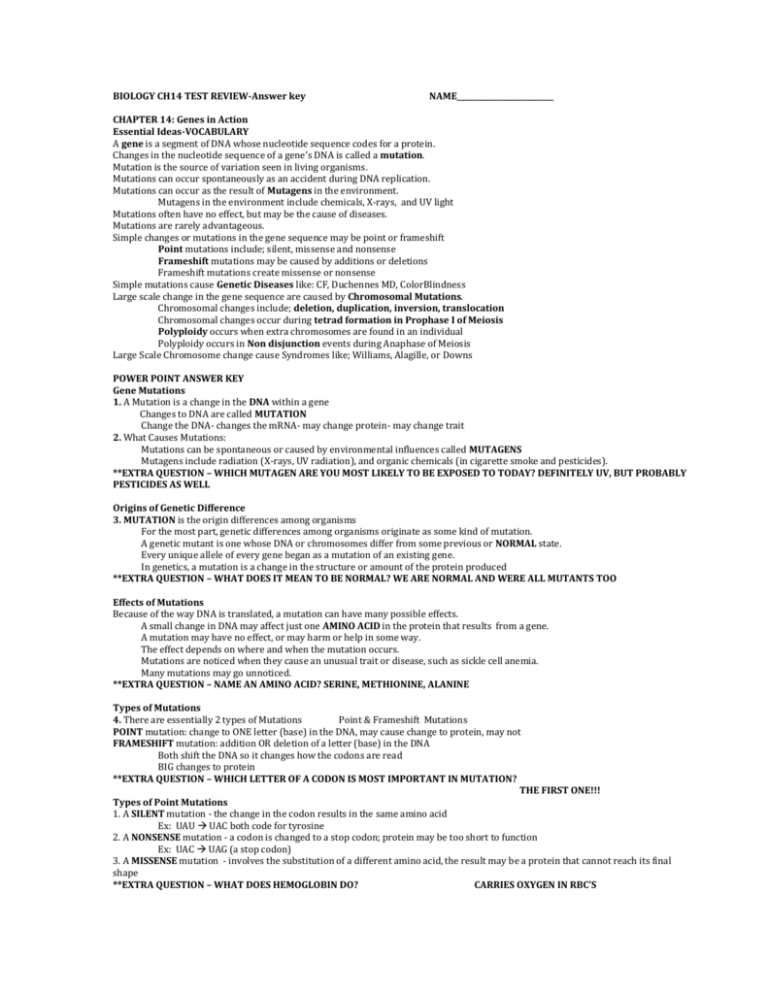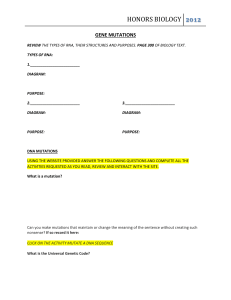bio ch14 test review c&c
advertisement

BIOLOGY CH14 TEST REVIEW-Answer key NAME__________________________ CHAPTER 14: Genes in Action Essential Ideas-VOCABULARY A gene is a segment of DNA whose nucleotide sequence codes for a protein. Changes in the nucleotide sequence of a gene’s DNA is called a mutation. Mutation is the source of variation seen in living organisms. Mutations can occur spontaneously as an accident during DNA replication. Mutations can occur as the result of Mutagens in the environment. Mutagens in the environment include chemicals, X-rays, and UV light Mutations often have no effect, but may be the cause of diseases. Mutations are rarely advantageous. Simple changes or mutations in the gene sequence may be point or frameshift Point mutations include; silent, missense and nonsense Frameshift mutations may be caused by additions or deletions Frameshift mutations create missense or nonsense Simple mutations cause Genetic Diseases like: CF, Duchennes MD, ColorBlindness Large scale change in the gene sequence are caused by Chromosomal Mutations. Chromosomal changes include; deletion, duplication, inversion, translocation Chromosomal changes occur during tetrad formation in Prophase I of Meiosis Polyploidy occurs when extra chromosomes are found in an individual Polyploidy occurs in Non disjunction events during Anaphase of Meiosis Large Scale Chromosome change cause Syndromes like; Williams, Alagille, or Downs POWER POINT ANSWER KEY Gene Mutations 1. A Mutation is a change in the DNA within a gene Changes to DNA are called MUTATION Change the DNA- changes the mRNA- may change protein- may change trait 2. What Causes Mutations: Mutations can be spontaneous or caused by environmental influences called MUTAGENS Mutagens include radiation (X-rays, UV radiation), and organic chemicals (in cigarette smoke and pesticides). **EXTRA QUESTION – WHICH MUTAGEN ARE YOU MOST LIKELY TO BE EXPOSED TO TODAY? DEFINITELY UV, BUT PROBABLY PESTICIDES AS WELL Origins of Genetic Difference 3. MUTATION is the origin differences among organisms For the most part, genetic differences among organisms originate as some kind of mutation. A genetic mutant is one whose DNA or chromosomes differ from some previous or NORMAL state. Every unique allele of every gene began as a mutation of an existing gene. In genetics, a mutation is a change in the structure or amount of the protein produced **EXTRA QUESTION – WHAT DOES IT MEAN TO BE NORMAL? WE ARE NORMAL AND WERE ALL MUTANTS TOO Effects of Mutations Because of the way DNA is translated, a mutation can have many possible effects. A small change in DNA may affect just one AMINO ACID in the protein that results from a gene. A mutation may have no effect, or may harm or help in some way. The effect depends on where and when the mutation occurs. Mutations are noticed when they cause an unusual trait or disease, such as sickle cell anemia. Many mutations may go unnoticed. **EXTRA QUESTION – NAME AN AMINO ACID? SERINE, METHIONINE, ALANINE Types of Mutations 4. There are essentially 2 types of Mutations Point & Frameshift Mutations POINT mutation: change to ONE letter (base) in the DNA, may cause change to protein, may not FRAMESHIFT mutation: addition OR deletion of a letter (base) in the DNA Both shift the DNA so it changes how the codons are read BIG changes to protein **EXTRA QUESTION – WHICH LETTER OF A CODON IS MOST IMPORTANT IN MUTATION? THE FIRST ONE!!! Types of Point Mutations 1. A SILENT mutation - the change in the codon results in the same amino acid Ex: UAU UAC both code for tyrosine 2. A NONSENSE mutation - a codon is changed to a stop codon; protein may be too short to function Ex: UAC UAG (a stop codon) 3. A MISSENSE mutation - involves the substitution of a different amino acid, the result may be a protein that cannot reach its final shape **EXTRA QUESTION – WHAT DOES HEMOGLOBIN DO? CARRIES OXYGEN IN RBC’S Frameshift Mutations The reading frame of a sequence depends on the starting point for reading. An insertion or deletion can shift the reading frame, or cause a frameshift. In FRAMESHIFT mutations, the remaining sequence may be “read” as different codons. Mutations as Changes in Results of Genes KNOW THIS!!!!If an insertion or deletion is a multiple of 3, the reading frame will be preserved. However, the protein that results may have a few more or less amino acids in it. **EXTRA QUESTION – IS A FRAMESHIFT MUTATION LIKELY TO PRODUCE A PROTEIN WITH ANY FUNCTION? NO!!!! ALL AMINO ACIDS ARE WRONG Some Common Genetic Diseases AKA Genetic Disorders Sickle Cell Anemia: MISSENSE MUTANT Defective Hemoglobin Gene-You can’t carry oxygen well Cystic Fibrosis: DELETION MUTANT Defective Protein is made that creates excess mucus; clogs lungs. Color Blindness: SEX LINKED Inablity to distinguish colors (8% of male population) Hemophilia: SEX LINKED Inablity of blood to clot Muscular Dystrophy: SEX LINKED Loss of muscle that begins in early childhood Degeneration of Central Nervous System; infant mortality LARGE-SCALE GENETIC CHANGE –GENETIC SYNDROMES 5. How can genetic change occur on a larger scale? Very large-scale genetic change can occur by misplacement, recombination, or multiplication of entire chromosomes. Chromosomal Mutations During meiosis, chromosomes pair up and may undergo crossover. Errors in the exchange can cause chromosomal mutations. Chromosomal Mutations A deletion occurs when a piece of a CHROMOSOME is lost.. Such deletions are usually harmful. A duplication occurs when a piece remains attached to its homologous chromosome after meiosis. An inversion occurs when a piece reattaches to its original chromosome, but in a reverse direction. A translocation occurs when a chromosome piece ends up in a completely different, nonhomologous chromosome. EFFECTS OF GENETIC CHANGE What are the possible effects of mutations? The results of genetic change may be harmful, beneficial, or NEUTRAL most changes are neutral and may not be passed on to offspring. **EXTRA QUESTION – ARE MOST CHANGES TO DNA BENEFICIAL- NEUTRAL – OR HARMFUL? NEUTRAL!!! The Formation of New Alleles For a given gene, many alleles, or variations, may exist. Any new allele must begin as a mutation of an existing allele. Most new alleles are simply the result of silent mutations, However, sometimes a new allele can cause a change in a gene’s function, a result that may be harmful or beneficial to the organism. (THIS IS HOW NEW SPECIES FORM!) LARGE-SCALE GENETIC CHANGES- can occur by misplacement, recombination, or multiplication of entire chromosomes. During the TETRAD FORMATION of Meiosis in Prophase I the alleles from one parent Recombine! Changes in Chromosome Number =POLYPLOIDY Nondisjunction – occurs when: In meiosis The result:Trisomy (3 copies of a single chromosome) or DOWNS SYNDROME =TRISOMY21 Changes in Chromosome Structure Chromosome mutation - a change in chromosome structure Types of chromosomal mutations: Inversion, Translocation , Deletion, Duplication. Chromosomal Deletion :Williams Syndrome- Chromosome 7 loses an end piece Children have a pixie look (turned-up noses, wide mouth, small chin, large ears) Poor academic skills, good verbal and musical abilities Chromosomal Duplication: inv Dup 15 syndrome Duplication results in a chromosome segment being REPEATED in the same chromosome inv Dup 15 syndrome. Poor muscle tone, mental retardation, seizures, curved spine, and autistic characteristics Chromosome Translocation: Alagille Syndrome Translocation is exchange of chromosomal segments between two, NON-HOMOLGOUSchromosomes. Ex: Alagille syndrome -Distinctive face, abnormalities of eyes & internal organs, and severe itching. Chromosome Inversion Inversion involves a segment of a chromosome being turned 180 degrees. The reverse sequence of alleles can alter gene activity. DNA Technology and Modern Medicine • The Human Genome Project Decoded an entire length of DNA in 2003 • The Genetic Sequencing allows for improvements in the detection and treatment of genetic disease and cancer. • Gene Therapy is a technology in which good copies of a gene are introduced into those individuals affected by genetic disease BIOLOGY NAME_________________________________ 1. WHAT IS A MUTATION? 2. WHAT ARE THE 2 TYPES OF GENETIC MUTATIONS? 3. LIST THE 3 TYPES OF POINT MUTATIONS AND BRIEFLY DESCRIBE EACH A B C 4. HOW DOES A FRAMESHIFT MUTATION OCCUR AND DESCRIBE IT BRIEFLY 5. LIST 4 GENETIC DISEASES OR DISORDERS AND DESCRIBE THEM BRIEFLY A B C D 6. WHEN DO CHROMOSOMAL MUTATIONS OCCUR? 7. LIST THE 4 TYPES OF CHROMOSOMAL MUTATIONS, BRIEFLY DESCRIBE EACH AND LIST AN ASSSOCIATED SYNDROME A B C D 8. WHAT IS POLYPLOIDY , HOW DOES IT OCCUR, AND GIVE A SYNDROME ASSOCIATED WITH IT 9. HOW IS A GENETIC SYNDROME DIFFERENT FROM A GENETIC DISEASE OR DISORDER? 10. WHAT IS GENE THERAPY AND HOW IS T RELATED TO THE HUMAN GENOME PROJECT?









